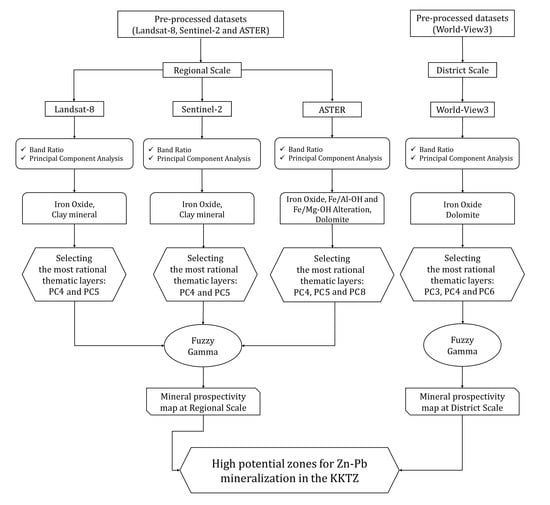Application of Landsat-8, Sentinel-2, ASTER and WorldView-3 Spectral Imagery for Exploration of Carbonate-Hosted Pb-Zn Deposits in the Central Iranian Terrane (CIT)
Abstract
:1. Introduction
2. Geologic Setting of the KKTZ
3. Materials and Methods
3.1. Multi-Sensor Data Characteristics
3.2. PrePprocessing of the Remote Sensing Datasets
3.3. Image Processing Techniques
3.3.1. Band Ratios
3.3.2. Principal Components Analysis (PCA)
3.3.3. Fuzzy Logic Modeling
3.4. Fieldwork Data and Laboratory Analysis
4. Results
4.1. Lithological and Alteration Mapping Using Landsat-8, Sentinel-2 and ASTER
4.2. Detailed Detection of Iron Oxide/Hydroxides and Dolomit Using WV-3
4.3. Generating Mineral Prospectivity Maps for the Study Area
4.4. Verifying the Spatial Distribution of Alteration Zones and High Prospective Areas
5. Discussion
6. Conclusions
Author Contributions
Funding
Acknowledgments
Conflicts of Interest
References
- Ahmadirouhani, R.; Karimpour, M.H.; Rahimi, B.; Malekzadeh-Shafaroudi, A.; Pour, A.B.; Pradhan, B. Integration of SPOT-5 and ASTER satellite data for structural tracing and hydrothermal alteration mineral mapping: Implications for Cu–Au prospecting. Int. J. Image Data Fusion 2018, 9, 237–262. [Google Scholar] [CrossRef]
- Rajendran, S.; Sobhi, N. ASTER capability in mapping of mineral resources of arid region: A review on mapping of mineral resources of the Sultanate of Oman. Ore Geol. Rev. 2018, 88, 317–335. [Google Scholar] [CrossRef]
- Pour, A.B.; Park, Y.; Park, T.S.; Hong, J.K.; Hashim, M.; Woo, J.; Ayoobi, I. Regional geology mapping using satellite-based remote sensing approach in Northern Victoria Land, Antarctica. Polar Sci. 2018, 16, 23–46. [Google Scholar] [CrossRef]
- Pour, A.B.; Hashim, M.; Park, Y.; Hong, J.K. Mapping alteration mineral zones and lithological units in Antarctic regions using spectral bands of ASTER remote sensing data. Geocarto Int. 2018, 33, 1281–1306. [Google Scholar] [CrossRef]
- Pour, A.B.; Park, T.S.; Park, Y.; Hong, J.K.; Zoheir, B.; Pradhan, B.; Ayoobi, I.; Hashim, M. Application of multi-sensor satellite data for exploration of Zn-Pb sulfide mineralization in the Franklinian Basin, North Greenland. Remote Sens. 2018, 10, 1186. [Google Scholar] [CrossRef] [Green Version]
- Hu, B.; Xu, Y.; Wan, B.; Wu, X.; Yi, G. Hydrothermally altered mineral mapping using synthetic application of Sentinel-2A MSI, ASTER and Hyperion data in the Duolong area, Tibetan Plateau, China. Ore Geol. Rev. 2018, 101, 384–397. [Google Scholar] [CrossRef]
- Abubakar, A.J.A.; Hashim, M.; Pour, A.B. Remote sensing satellite imagery for prospecting geothermal systems in an aseismic geologic setting: Yankari Park, Nigeria. Int. J. Appl. Earth Obs. Geoinf. 2019, 80, 157–172. [Google Scholar] [CrossRef]
- Sheikhrahimi, A.; Pour, A.B.; Pradhan, B.; Zoheir, B. Mapping hydrothermal alteration zones and lineaments associated with orogenic gold mineralization using ASTER data: A case study from the Sanandaj-Sirjan Zone, Iran. Adv. Space Res. 2019, 63, 3315–3332. [Google Scholar] [CrossRef]
- Feng, Y.; Xiao, B.; Li, R.; Deng, C.; Han, J.; Wu, C.; Lai, C. Alteration mapping with short wavelength infrared (SWIR) spectroscopy on Xiaokelehe porphyry Cu-Mo deposit in the Great Xing’an Range, NE China: Metallogenic and exploration implications. Ore Geol. Rev. 2019, 112, 103062. [Google Scholar] [CrossRef]
- Xu, Y.; Meng, P.; Chen, J. Study on clues for gold prospecting in the Maizijing-Shulonggou area, Ningxia Hui autonomous region, China, using ALI, ASTER and WorldView-2 imagery. J. Vis. Commun. Image Represent. 2019, 60, 192–205. [Google Scholar] [CrossRef]
- Hosseini, S.; Lashkaripour, G.R.; Moghadas, N.H.; Ghafoori, M.; Pour, A.B. Lineament mapping and fractal analysis using SPOT-ASTER satellite imagery for evaluating the severity of slope weathering process. Adv. Space Res. 2019, 63, 871–885. [Google Scholar] [CrossRef]
- Pour, A.B.; Hashim, M.; Hong, J.K.; Park, Y. Lithological and alteration mineral mapping in poorly exposed lithologies using Landsat-8 and ASTER satellite data: North-eastern Graham Land, Antarctic Peninsula. Ore Geol. Rev. 2019, 108, 112–133. [Google Scholar] [CrossRef]
- Pour, A.B.; Park, Y.; Crispini, L.; Läufer, A.; Kuk Hong, J.; Park, T.-Y.S.; Zoheir, B.; Pradhan, B.; Muslim, A.M.; Hossain, M.S.; et al. Mapping Listvenite Occurrences in the Damage Zones of Northern Victoria Land, Antarctica Using ASTER Satellite Remote Sensing Data. Remote Sens. 2019, 11, 1408. [Google Scholar] [CrossRef] [Green Version]
- Pour, A.B.; Park, T.-Y.; Park, Y.; Hong, J.K.; Muslim, A.M.; Läufer, A.; Crispini, L.; Pradhan, B.; Zoheir, B.; Rahmani, O.; et al. Landsat-8, Advanced Spaceborne Thermal Emission and Reflection Radiometer, and WorldView-3 Multispectral Satellite Imagery for Prospecting Copper-Gold Mineralization in the Northeastern Inglefield Mobile Belt (IMB), Northwest Greenland. Remote Sens. 2019, 11, 2430. [Google Scholar] [CrossRef] [Green Version]
- Bolouki, S.M.; Ramazi, H.R.; Maghsoudi, A.; Beiranvand Pour, A.; Sohrabi, G. A Remote Sensing-Based Application of Bayesian Networks for Epithermal Gold Potential Mapping in Ahar-Arasbaran Area, NW Iran. Remote Sens. 2020, 12, 105. [Google Scholar] [CrossRef] [Green Version]
- Molan, Y.E.; Behnia, P. Prospectivity mapping of Pb–Zn SEDEX mineralization using remote-sensing data in the Behabad area, Central Iran. Int. J. Remote Sens. 2013, 34, 1164–1179. [Google Scholar] [CrossRef]
- Niyeh, M.M.; Jafarirad, A.; Karami, J.; Bokani, S.J. Copper, Zinc, and Lead Mineral Prospectivity Mapping in the North of Tafresh, Markazi Province, Central Iran, Using the AHP-OWA Method. Open J. Geol. 2017, 7, 533. [Google Scholar] [CrossRef] [Green Version]
- Govil, H.; Gill, N.; Rajendran, S.; Santosh, M.; Kumar, S. Identification of new base metal mineralization in Kumaon Himalaya, India, using hyperspectral remote sensing and hydrothermal alteration. Ore Geol. Rev. 2018, 92, 271–283. [Google Scholar] [CrossRef]
- Yang, M.; Ren, G.; Han, L.; Yi, H.; Gao, T. Detection of Pb–Zn mineralization zones in west Kunlun using Landsat 8 and ASTER remote sensing data. J. Appl. Remote Sens. 2018, 12, 026018. [Google Scholar] [CrossRef]
- World Bank Commodities Price Forecast (Nominal US Dollars). 2019. Available online: https://openknowledge.worldbank.org/bitstream/handle/10986/31549/CMO-April-19.pdf (accessed on 24 August 2019).
- Bhavan, I.; Lines, C. Indian Minerals Yearbook 2018 (Part-II: Metals and Alloys), 57th ed.; Lead & Zinc: Lisbon, Portugal, 2019; pp. 1–30. [Google Scholar]
- Leach, D.L.; Bradley, D.C.; Huston, D.; Pisarevsky, S.A.; Taylor, R.D.; Gardoll, S.J. Sediment-hosted lead-zinc deposits in Earth history. Econ. Geol. 2010, 105, 593–625. [Google Scholar] [CrossRef]
- Leach, D.L.; Taylor, R.D.; Fey, D.L.; Diehl, S.F.; Saltus, R.W. A deposit model for Mississippi Valley-Type lead-zinc ores. In Mineral Deposit Models for Resource Assessment; USGS Scientific Investigations Report 5070-A; U.S. Geological Survey: Reston, VA, USA, 2010; Chapter A; p. 52. [Google Scholar]
- Taylor, R.D.; Leach, D.L.; Bradley, D.C.; Pisarevsky, S.A. Compilation of Mineral Resource Data for Mississippi Valley-Type and Clastic-Dominated Sediment-Hosted Lead-Zinc Deposits; USGS Open-File Report; U.S. Geological Survey: Reston, VA, USA, 2009; p. 42.
- Parvaz, D.B. Oxidation Zones of Volcanogenic Massive Sulphide Deposits in the Troodos Ophiolite, Cyprus: Targeting Secondary Copper Deposits. Ph.D. Thesis, University of Exeter, Exeter, UK, 2014. [Google Scholar]
- Rajabi, A.; Rastad, E.; Canet, C. Metallogeny of Cretaceous carbonate-hosted Zn–Pb deposits of Iran: Geotectonic setting and data integration for future mineral exploration. Int. Geol. Rev. 2012, 54, 1649–1672. [Google Scholar] [CrossRef]
- Haghipour, A.; Pelissier, G. Geology of the Saghand Sector. In Explanatory Text of the Ardekan Quadrangle Map; Haghipour, A., Valeh, N., Pelissier, G., Davoudzadeh, M., Eds.; Geological Survey of Iran: Tehran, Iran, 1977; pp. 10–68. [Google Scholar]
- Masoodi, M.; Yassaghi, A.; Nogole Sadat, M.A.A.; Neubauer, F.; Bernroider, M.; Friedl, G.; Houshmandzadeh, A. Cimmerian evolution of the Central Iranian basement: Evidence from metamorphic units of the Kashmar–Kerman Tectonic Zone. Tectonophysics 2013, 588, 189–208. [Google Scholar] [CrossRef]
- Ghanbari, Y.; Hezarkhani, A.; Ataei, M.; Pazand, K. Mineral potential mapping with fuzzy models in the Kerman–Kashmar Tectonic Zone, Central Iran. Appl. Geomat. 2012, 4, 173–186. [Google Scholar] [CrossRef]
- Huckriede, R.; Kürsten, M.; Venzlaff, H. Zur geologie des gebietes zwischen Kerman und Sagand (Iran): Beihefte zum. Geol. Jahrb. 1962, 51, 1–97. [Google Scholar]
- Stöcklin, J. Structural history and tectonics of Iran: A review. Bull. Am. Assoc. Pet. Geol. 1968, 52, 1229–1258. [Google Scholar]
- Davoudzadeh, M.; Lensch, G.; Weber-Diefenbach, K. Contribution to the paleogeography, stratigraphy and tectonics of the Infracambrian and lower Paleozoic of Iran. Neues Jahrb. Geol. Paläontologie Abh. 1986, 172, 245–269. [Google Scholar]
- Ramezani, J.; Tucker, R.D. The Saghand region, central Iran: U-Pb geochronology, petrogenesis and implications for Gondwana tectonics. Am. J. Sci. 2003, 303, 622–665. [Google Scholar] [CrossRef]
- Aghanabati, A. Geology of Iran; Geological Survey of Iran: Tehran, Iran, 2004; p. 587.
- Berberian, M.; King, G.C.P. Towards a Paleogeography and tectonic evolution of Iran. Can. J. Earth Sci. 1981, 18, 210–265. [Google Scholar] [CrossRef]
- Haghipour, A. Geological Map of the Posht-e-Badam Area 1: 100 000; Geological Survey of Iran: Tehran, Iran, 1977.
- Haghipour, A.; Pelissier, G. Geology of the Posht-e-Badam-Saghand area (east central Iran). Iran Geol. Surv. Note 1968, 48, 144. [Google Scholar]
- Samani, B.A. Metallogeny of the Precambrian in Iran. Precambrian Res. 1988, 39, 85–106. [Google Scholar] [CrossRef]
- Husseini, M.I. Tectonic and deposition model of late Precambrian-Cambrian Arabian and adjoining plates. AAPG Bull. 1989, 73, 1117–1131. [Google Scholar]
- Foerster, H.; Jafarzadeh, A. The Bafq mining district in central Iran; a highly mineralized Infracambrian volcanic field. Econ. Geol. 1994, 89, 1697–1721. [Google Scholar] [CrossRef]
- Sennewald, S. Resurgent Cauldrons and Their mineralization between Narigan, Esfordi, Kushk, and Seh Chahoon, Central Iran. Int. J. Eng. 1988, 1, 149–161. [Google Scholar]
- Drusch, M.; Del Bello, U.; Carlier, S.; Colin, O.; Fernandez, V.; Gascon, F.; Meygret, A.; Spoto, F.; Sy, O.; Marchese, F.; et al. Sentinel-2: ESA’s optical high-resolution mission for GMES operational services. Remote Sens. Environ. 2012, 120, 25–36. [Google Scholar] [CrossRef]
- Irons, J.R.; Dwyer, J.L.; Barsi, J.A. The next Landsat satellite: The Landsat data continuity mission. Remote Sens. Environ. 2012, 122, 11–21. [Google Scholar] [CrossRef] [Green Version]
- Roy, D.P.; Wulder, M.A.; Loveland, T.A.; Woodcock, C.E.; Allen, R.G.; Anderson, M.C.; Scambos, T.A. Landsat-8: Science and product vision for terrestrial global change research. Remote Sens. Environ. 2014, 145, 154–172. [Google Scholar] [CrossRef] [Green Version]
- DigitalGlobe. WorldView-3 Datasheet. 2014. Available online: https://www.digitalglobe.com/sites/default/files/DG_WorldView3_DS_forWeb_0.pdf (accessed on 24 September 2019).
- Abrams, M.; Tsu, H.; Hulley, G.; Iwao, K.; Pieri, D.; Cudahy, T.; Kargel, J. The Advanced Spaceborne Thermal Emission and Reflection Radiometer (ASTER) after fifteen years: Review of global products. Int. J. Appl. Earth Obs. Geoinf. 2015, 38, 292–301. [Google Scholar] [CrossRef]
- Lima, T.A.; Beuchle, R.; Langner, A.; Grecchi, R.C.; Griess, V.C.; Achard, F. Comparing Sentinel-2 MSI and Landsat 8 OLI Imagery for Monitoring Selective Logging in the Brazilian Amazon. Remote Sens. 2019, 11, 961. [Google Scholar] [CrossRef] [Green Version]
- U.S. Geological Survey Earth Resources Observation and Science Center (EROS). Available online: https://earthexplorer.usgs.gov/ (accessed on 2 June 2019).
- Pieschke, R.L. US Geological Survey Distribution of European Space Agency’s Sentinel-2 Data; No. 2017-3026; US Geological Survey: Reston, VA, USA, 2017.
- USGS EROS Center. Available online: https://earthexplorer.usgs.gov/ (accessed on 28 March 2019).
- Kuester, M. Radiometric Use of WV-3 Imagery; Technical Note; DigitalGlobe: Westminster, CO, USA, 2016; p. 12. [Google Scholar]
- Kuester, M.A.; Ochoa, M.; Dayer, A.; Levin, J.; Aaron, D.; Helder, D.L.; Leigh, L.; Czapla-Meyers, J.; Anderson, N.; Bader, B.; et al. Absolute Radiometric Calibration of the DigitalGlobe Fleet and Updates on the New WV-3 Sensor Suite; Technical Note; DigitalGlobe: Westminster, CO, USA, 2015; p. 16. [Google Scholar]
- ENVI. Environment for Visualizing Images. Available online: http://www.exelisvis.com (accessed on 12 February 2019).
- Cooley, T.; Anderson, G.P.; Felde, G.W.; Hoke, M.L.; Ratkowski, A.J.; Chetwynd, J.H.; Gardner, J.A.; Adler-Golden, S.M.; Matthew, M.W.; Berk, A.; et al. FLAASH, a MODTRAN4-based atmospheric correction algorithm, its application and validation. In Proceedings of the IEEE International Geoscience and Remote Sensing Symposium, Toronto, ON, Canada, 24–28 June 2002; Volume 3, pp. 1414–1418. [Google Scholar]
- Research Systems, Inc. ENVI Tutorials; Research Systems, Inc.: Boulder, CO, USA, 2008. [Google Scholar]
- Rahaman, K.; Hassan, Q.; Ahmed, M. Pan-sharpening of Landsat-8 images and its application in calculating vegetation greenness and canopy water contents. ISPRS Int. J. Geo Inf. 2017, 6, 168. [Google Scholar] [CrossRef] [Green Version]
- Ben-Dor, E.; Kruse, F.A.; lefkoff, A.B.; Banin, A. Comparison of three calibration techniques for utilization of GER 63-channel aircraft scanner data of Makhtesh Ramon, Nega, Israel. Int. J. Rock Mech. Min. Sci. Geomech. Abstr. 1995, 32, 164A. [Google Scholar]
- Iwasaki, A.; Tonooka, H. Validation of a crosstalk correction algorithm for ASTER/SWIR. IEEE Trans. Geosci. Remote Sens. 2005, 43, 2747–2751. [Google Scholar] [CrossRef]
- Kalinowski, A.; Oliver, S. ASTER mineral index processing manual. Remote Sens. Appl. Geosci. Aust. 2004, 37, 36. [Google Scholar]
- Mars, J.C.; Rowan, L.C. Regional mapping of phyllic- and argillic-altered rocks in the Zagros magmatic arc, Iran, using Advanced Spaceborne Thermal Emission and Reflection Radiometer (ASTER) data and logical operator algorithms. Geosphere 2006, 7, 276–289. [Google Scholar] [CrossRef] [Green Version]
- Pour, B.A.; Hashim, M. Identification of hydrothermal alteration minerals for exploring of porphyry copper deposit using ASTER data, SE Iran. J. Asian Earth Sci. 2011, 42, 1309–1323. [Google Scholar] [CrossRef]
- Pour, B.A.; Hashim, M. The application of ASTER remote sensing data to porphyry copper and epithermal gold deposits. Ore Geol. Rev. 2012, 44, 1–9. [Google Scholar] [CrossRef] [Green Version]
- Eldosouky, A.M.; Sehsah, H.; Elkhateeb, S.O.; Pour, A.B. Integrating aeromagnetic data and Landsat-8 imagery for detection of post-accretionary shear zones controlling hydrothermal alterations: The Allaqi-Heiani Suture zone, South Eastern Desert, Egypt. Adv. Space Res. 2019. [Google Scholar] [CrossRef]
- Inzana, J.; Kusky, T.; Higgs, G.; Tucker, R. Supervised classifications of Landsat TM band ratio images and Landsat TM band ratio image with radar for geological interpretations of central Madagascar. J. Afr. Earth Sci. 2003, 37, 59–72. [Google Scholar] [CrossRef]
- Di Tommaso, I.; Rubinstein, N. Hydrothermal alteration mapping using ASTER data in the Infiernillo porphyry deposit, Argentina. Ore Geol. Rev. 2007, 32, 275–290. [Google Scholar] [CrossRef]
- Rockwell, B.W.; Hofstra, A.H. Identification of quartz and carbonate minerals across Northern Nevada using ASTER thermal infrared emissivity data, implications for geologic mapping and mineral resource investigations in well-studied and frontier areas. Geosphere 2008, 4, 218–246. [Google Scholar] [CrossRef] [Green Version]
- Mars, J.C.; Rowan, L.C. ASTER spectral analysis and lithologic mapping of the Khanneshin carbonate volcano, Afghanistan. Geosphere 2011, 7, 276–289. [Google Scholar] [CrossRef] [Green Version]
- Colby, J.D. Topographic normalization in rugged terrain. Photogramm. Eng. Remote Sens. 1991, 57, 531–537. [Google Scholar]
- Crowley, J.K.; Brickey, D.W.; Rowan, L.C. Airborne imaging spectrometer data of the Ruby Mountains, Montana: Mineral discrimination using relative absorption band-depth images. Remote Sens. Environ. 1989, 29, 121–134. [Google Scholar] [CrossRef]
- Ninomiya, Y.; Fu, B.; Cudahy, T.J. Detecting lithology with Advanced Spaceborne Thermal Emission and Reflection Radiometer (ASTER) multispectral thermal infrared radiance-at-sensor data. Remote Sens. Environ. 2005, 99, 127–139. [Google Scholar] [CrossRef]
- Ninomiya, Y.; Fu, B. Regional lithological mapping using ASTER-TIR data: Case study for the Tibetan Plateau and the surrounding area. Geosciences 2016, 6, 39. [Google Scholar] [CrossRef] [Green Version]
- Ninomiya, Y.; Fu, B. Thermal infrared multispectral remote sensing of lithology and mineralogy based on spectral properties of materials. Ore Geol. Rev. 2018. [Google Scholar] [CrossRef]
- Hunt, G.R. Spectral signatures of particulate minerals in the visible and near infrared. Geophysics 1977, 42, 501–513. [Google Scholar] [CrossRef] [Green Version]
- Clark, R.N. Spectroscopy of rock and minerals and principles of spectroscopy. In Remote Sensing for the Earth Sciences: Manual of Remote Sensing 3; Rencz, A.N., Ed.; John Wiley Sons: New York, NY, USA, 1999; pp. 3–58. [Google Scholar]
- Hunt, G.R.; Ashley, R.P. Spectra of altered rocks in the visible and near-infrared. Econ. Geol. 1979, 74, 1613–1629. [Google Scholar] [CrossRef]
- Mars, J.C.; Rowan, L.C. Spectral assessment of new ASTER SWIR surface reflectance data products for spectroscopic mapping of rocks and minerals. Remote Sens. Environ. 2010, 114, 2011–2025. [Google Scholar] [CrossRef]
- Rowan, L.C.; Mars, J.C. Lithologic mapping in the Mountain Pass area, California using Advanced Spaceborne Thermal Emission and Reflection Radiometer (ASTER) data. Remote Sens. Environ. 2003, 84, 350–366. [Google Scholar] [CrossRef]
- Kuosmanen, V.; Laitinen, J.; Arkimaa, H.; Kuosmanen, E. Hyperspectral Characterization of Selected Remote Detection Targets in the Mines of HYDO Partners; Archive Report, RS/2000/02; Geological Survey of Finland: Espoo, Finland, 2000.
- Sun, Y.; Tian, S.; Di, B. Extracting mineral alteration information using Worldview-3 data. Geosci. Front. 2017, 8, 1051–1062. [Google Scholar] [CrossRef]
- Mars, J.C. Mineral and Lithologic Mapping Capability of WorldView 3 Data at Mountain Pass, California, Using True-and False-Color Composite Images, Band Ratios, and Logical Operator Algorithms. Econ. Geol. 2018, 113, 1587–1601. [Google Scholar] [CrossRef] [Green Version]
- Bedini, E. Application of WorldView-3 imagery and ASTER TIR data to map alteration minerals associated with the Rodalquilar gold deposits, southeast Spain. Adv. Space Res. 2019, 63, 3346–3357. [Google Scholar] [CrossRef]
- Gaffey, S.J. Spectral reflectance of carbonate minerals in the visible and near-infrared (0.35–2.55 microns): Calcite, aragonite, and dolomite. Am. Mineral. 1986, 71, 151–162. [Google Scholar]
- Singh, A.; Harrison, A. Standardized principal components. Int. J. Remote Sens. 1985, 6, 883–896. [Google Scholar] [CrossRef]
- Crosta, A.P.; Souza Filho, C.R.; Azevedo, F.; Brodie, C. Targeting key alteration minerals in epithermal deposits in Patagonia, Argentina, Using ASTER imagery and principal component analysis. Int. J. Remote Sens. 2003, 24, 4233–4240. [Google Scholar] [CrossRef]
- Gupta, R.P.; Tiwari, R.K.; Saini, V.; Srivastava, N. A simplified approach for interpreting principal component images. Adv. Remote Sens. 2013, 2, 111–119. [Google Scholar] [CrossRef] [Green Version]
- Eklundh, L.; Singh, A. A comparative analysis of standardized and unstandardized principal component analysis in remote sensing. Int. J. Remote Sens. 1993, 14, 1359–1370. [Google Scholar] [CrossRef]
- Chang, Q.; Jing, L.; Panahi, A. Principal component analysis with optimum order sample correlation coefficient for image enhancement. Int. J. Remote Sens. 2006, 27, 3387–3401. [Google Scholar]
- Crosta, A.; Moore, J. Enhancement of Landsat Thematic Mapper imagery for residual soil mapping in SW Minais Gerais State, Brazil: A prospecting case history in Greenstone belt terrain. In Proceedings of the 7th ERIM Thematic Conference: Remote Sensing for Exploration Geology, Calgary, AB, Canada, 2–6 October 1989; pp. 1173–1187. [Google Scholar]
- Loughlin, W.P. Principal components analysis for alteration mapping. Photogramm. Eng. Remote Sens. 1991, 57, 1163–1169. [Google Scholar]
- Pour, B.A.; Hashim, M.; Marghany, M. Exploration of gold mineralization in a tropical region using Earth Observing-1 (EO1) and JERS-1 SAR data: A case study from Bau gold field, Sarawak, Malaysia. Arab. J. Geosci. 2014, 7, 2393–2406. [Google Scholar] [CrossRef]
- Noori, L.; Pour, B.A.; Askari, G.; Taghipour, N.; Pradhan, B.; Lee, C.-W.; Honarmand, M. Comparison of Different Algorithms to Map Hydrothermal Alteration Zones Using ASTER Remote Sensing Data for Polymetallic Vein-Type Ore Exploration: Toroud–Chahshirin Magmatic Belt (TCMB), North Iran. Remote Sens. 2019, 11, 495. [Google Scholar] [CrossRef] [Green Version]
- Zoheir, B.; El-Wahed, M.A.; Pour, A.B.; Abdelnasser, A. Orogenic Gold in Transpression and Transtension Zones: Field and Remote Sensing Studies of the Barramiya–Mueilha Sector, Egypt. Remote Sens. 2019, 11, 2122. [Google Scholar] [CrossRef] [Green Version]
- Zadeh, L.A. Fuzzy sets. Inf. Control 1965, 8, 338–353. [Google Scholar] [CrossRef] [Green Version]
- Novák, V.; Perfilieva, I.; Močkoř, J. Mathematical Principles of Fuzzy Logic; Kluwer Academic: Dordrecht, The Netherlands, 1999; ISBN 978-0-7923-8595-0. [Google Scholar]
- Nykänen, V.; Groves, D.I.; Ojala, V.J.; Eilu, P.; Gardoll, S.J. Reconnaissance-scale conceptual fuzzy-logic prospectivity modelling for iron oxide copper—Gold deposits in the northern Fennoscandian Shield, Finland. Aust. J. Earth Sci. 2008, 55, 25–38. [Google Scholar] [CrossRef]
- Carranza, E.J.M. Geochemical Anomaly and Mineral Prospectivity Mapping in GIS; Elsevier: Amsterdam, The Netherlands, 2008; Volume 11. [Google Scholar]
- Zhang, N.; Zhou, K.; Du, X. Application of fuzzy logic and fuzzy AHP to mineral prospectivity mapping of porphyry and hydrothermal vein copper deposits in the Dananhu-Tousuquan island arc, Xinjiang, NW China. J. Afr. Earth Sci. 2017, 128, 84–96. [Google Scholar] [CrossRef]
- Kim, Y.H.; Choe, K.U.; Ri, R.K. Application of fuzzy logic and geometric average: A Cu sulfide deposits potential mapping case study from Kapsan Basin, DPR Korea. Ore Geol. Rev. 2019, 107, 239–247. [Google Scholar] [CrossRef]
- Zimmermann, H.J.; Zysno, P. Latent connectives in human decision making. Fuzzy Sets Syst. 1980, 4, 37–51. [Google Scholar] [CrossRef]
- An, P.; Moon, W.M.; Rencz, A. Application of fuzzy set theory to integrated mineral exploration. Can. J. Explor. Geophys. 1991, 27, 1–11. [Google Scholar]
- Bonham-Carter, G.F. Geographic information systems for geoscientists-modeling with GIS. Comput. Methods Geosci. 1994, 13, 398. [Google Scholar]
- Carranza, E.J.M.; Hale, M. Geologically constrained fuzzy mapping of gold mineralization potential, Bauio District, Philippines. Nat. Resour. Res. 2001, 10, 125–136. [Google Scholar] [CrossRef]
- Bishop, J.L.; Lane, M.D.; Dyar, M.D.; Brwon, A.J. Reflectance and emission spectroscopy study of four groups of phyllosilicates: Smectites, kaolinite-serpentines, chlorites and micas. Clay Miner. 2008, 43, 35–54. [Google Scholar] [CrossRef]
- Cloutis, E.A.; Hawthorne, F.C.; Mertzman, S.A.; Krenn, K.; Craig, M.A.; Marcino, D.; Methot, M.; Strong, J.; Mustard, J.F.; Blaney, D.L.; et al. Detection and discrimination of sulfate minerals using reflectance spectroscopy. Icarus 2006, 184, 121–157. [Google Scholar] [CrossRef]
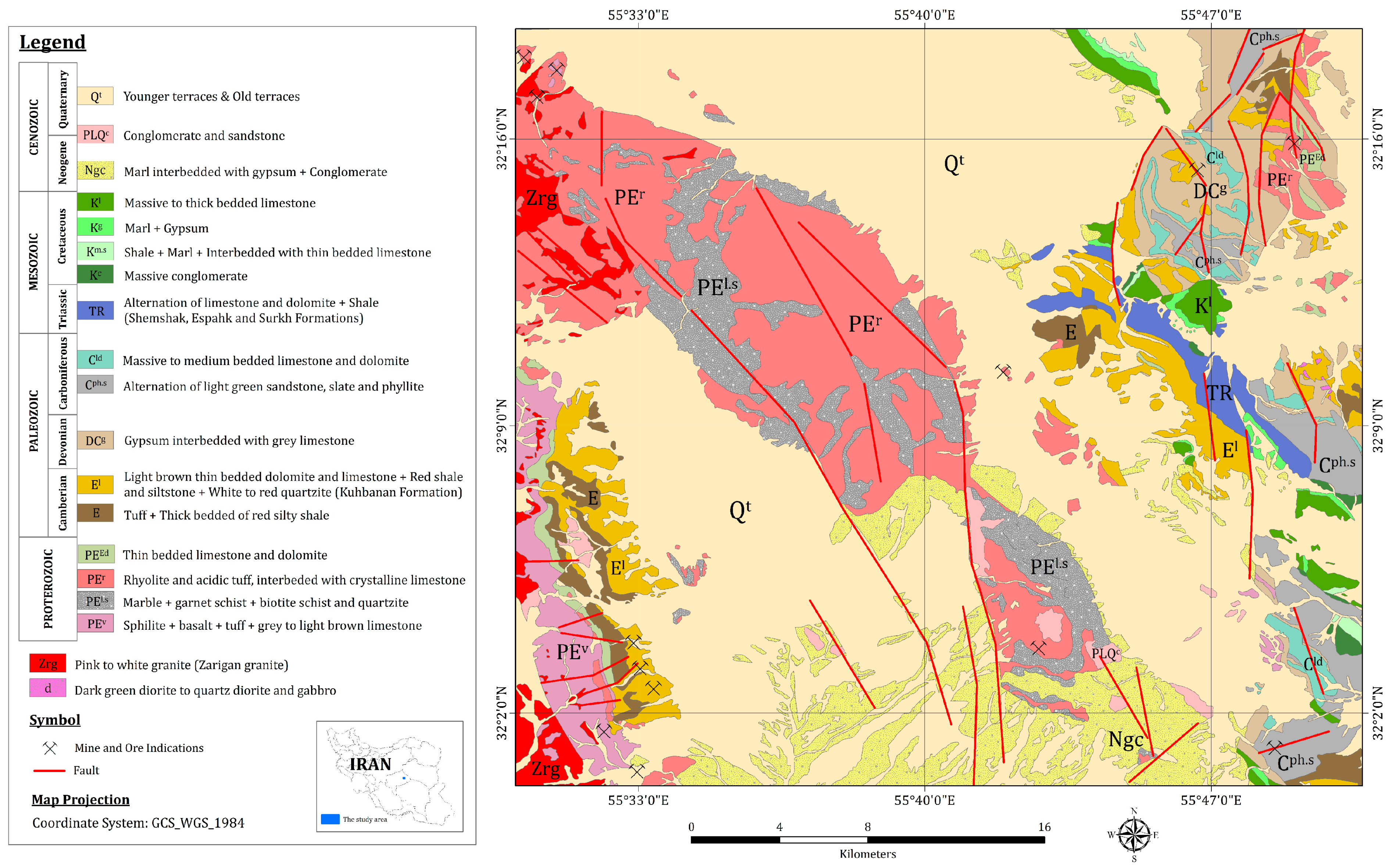
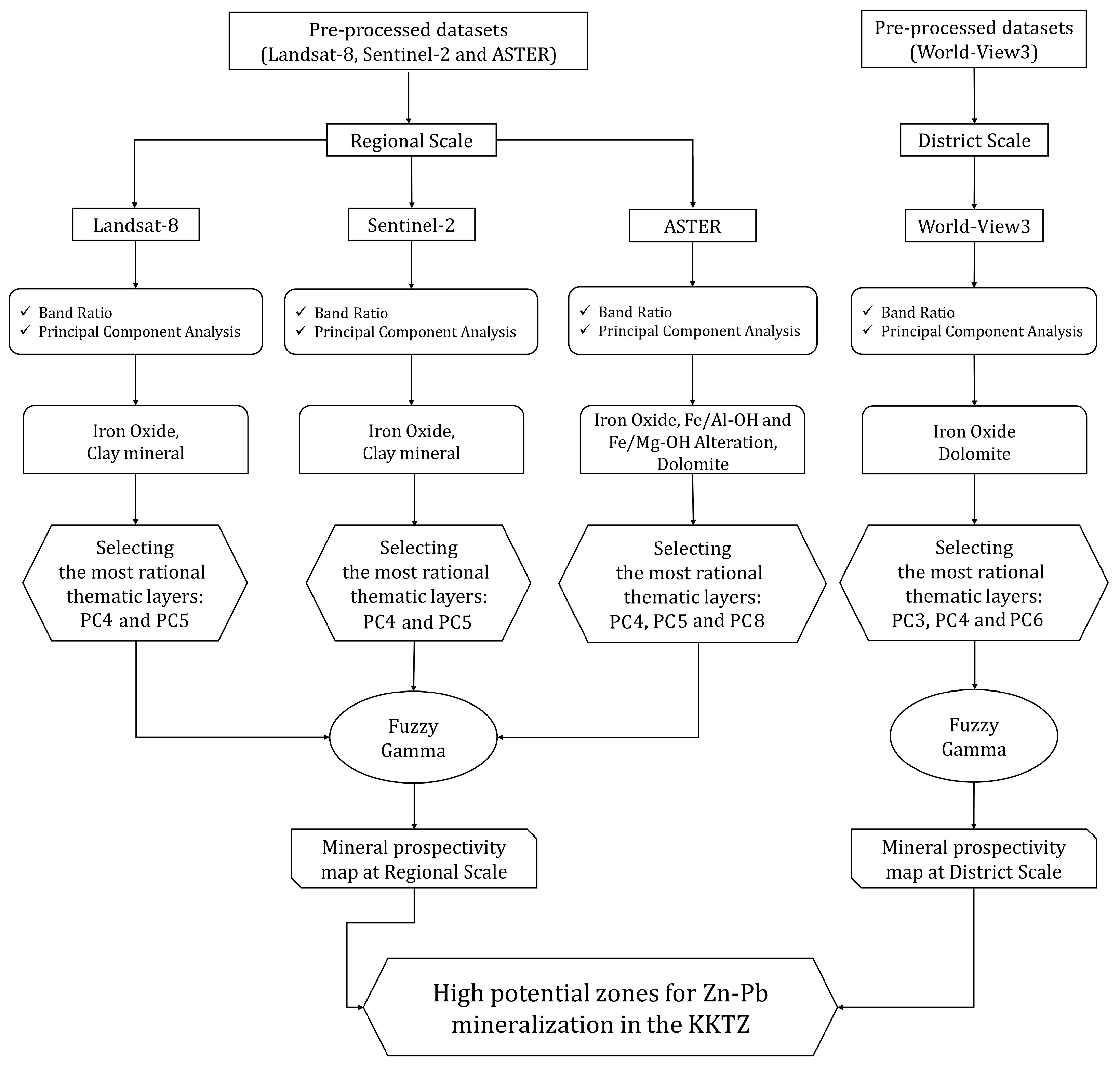
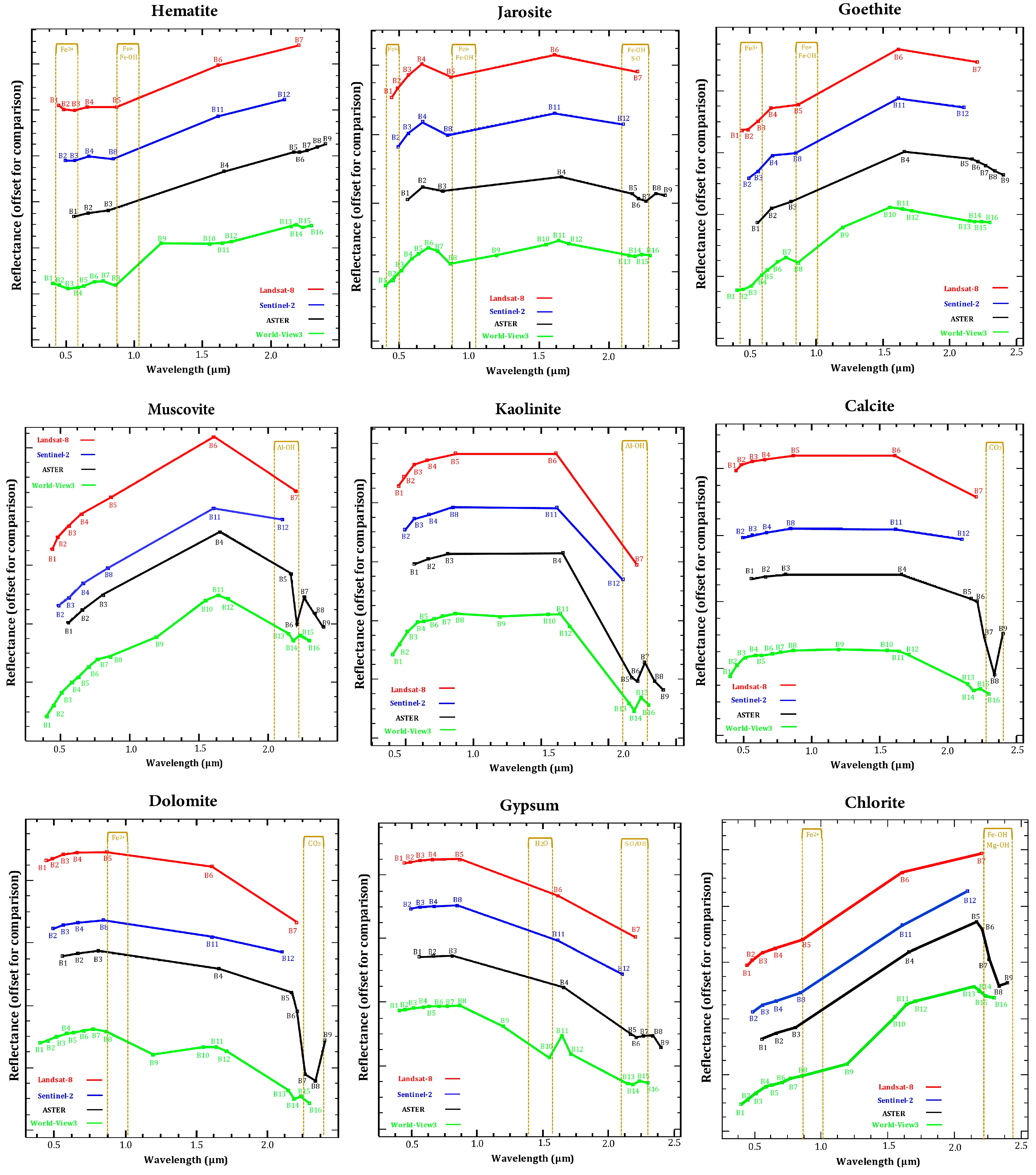
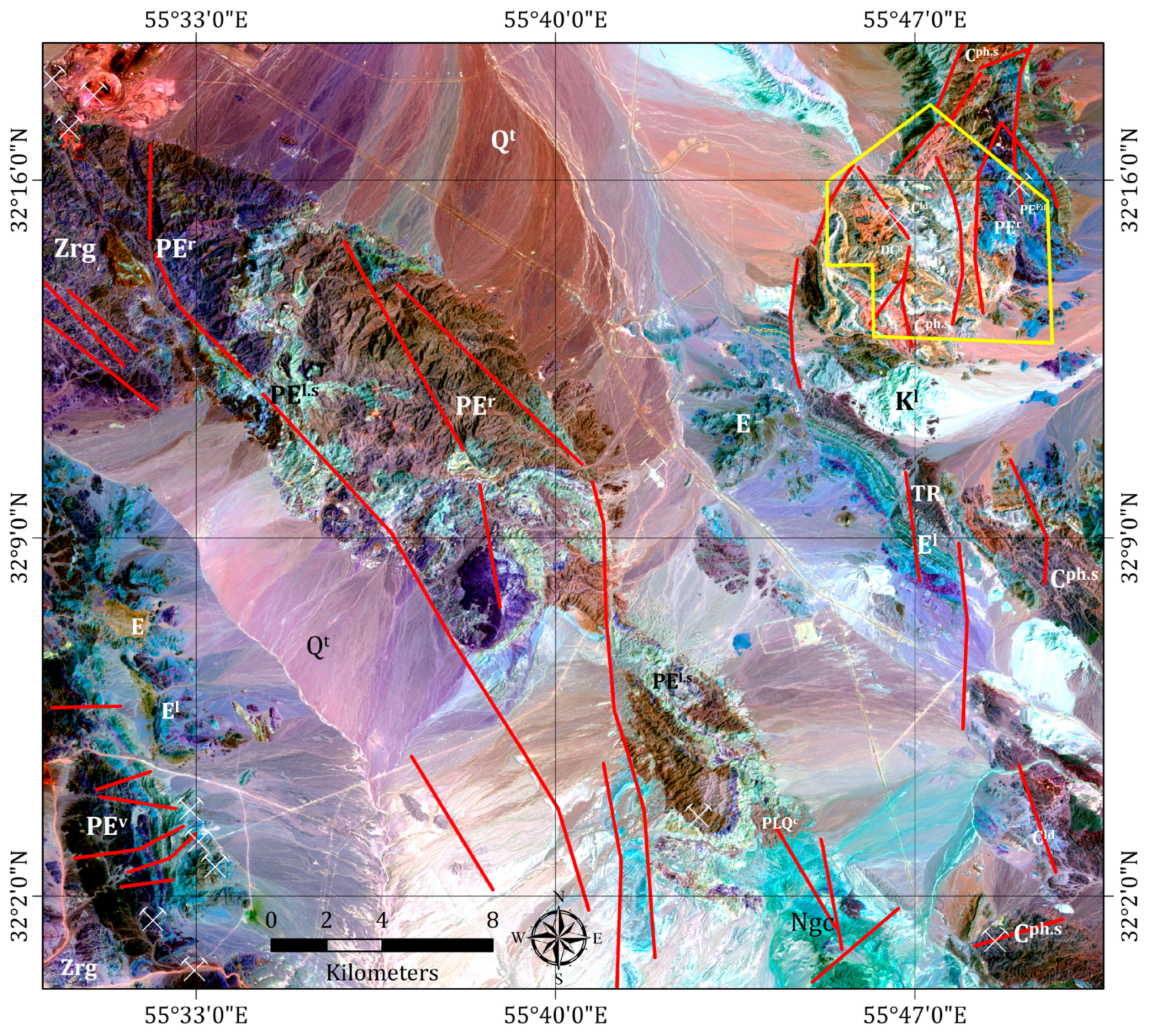
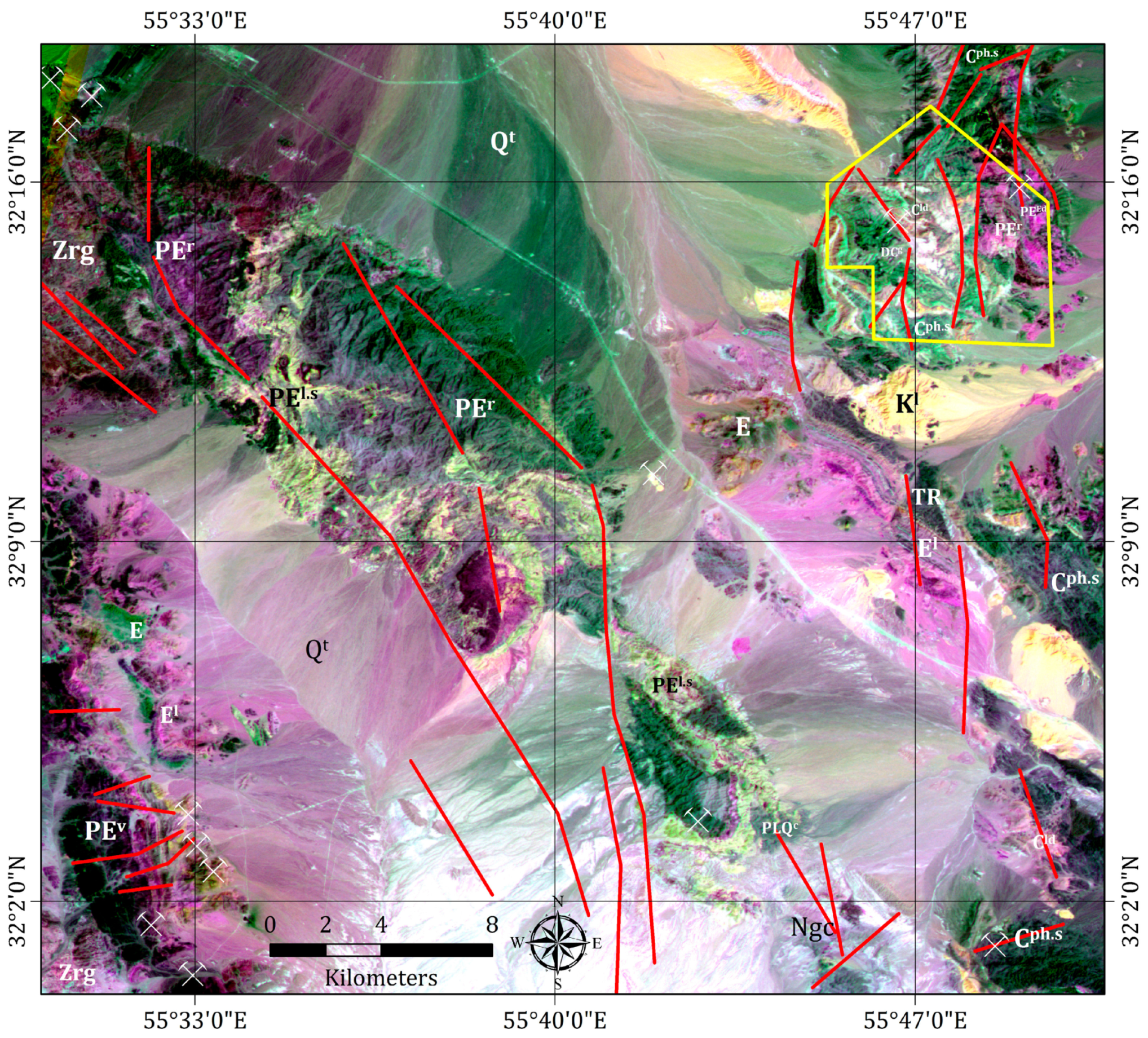

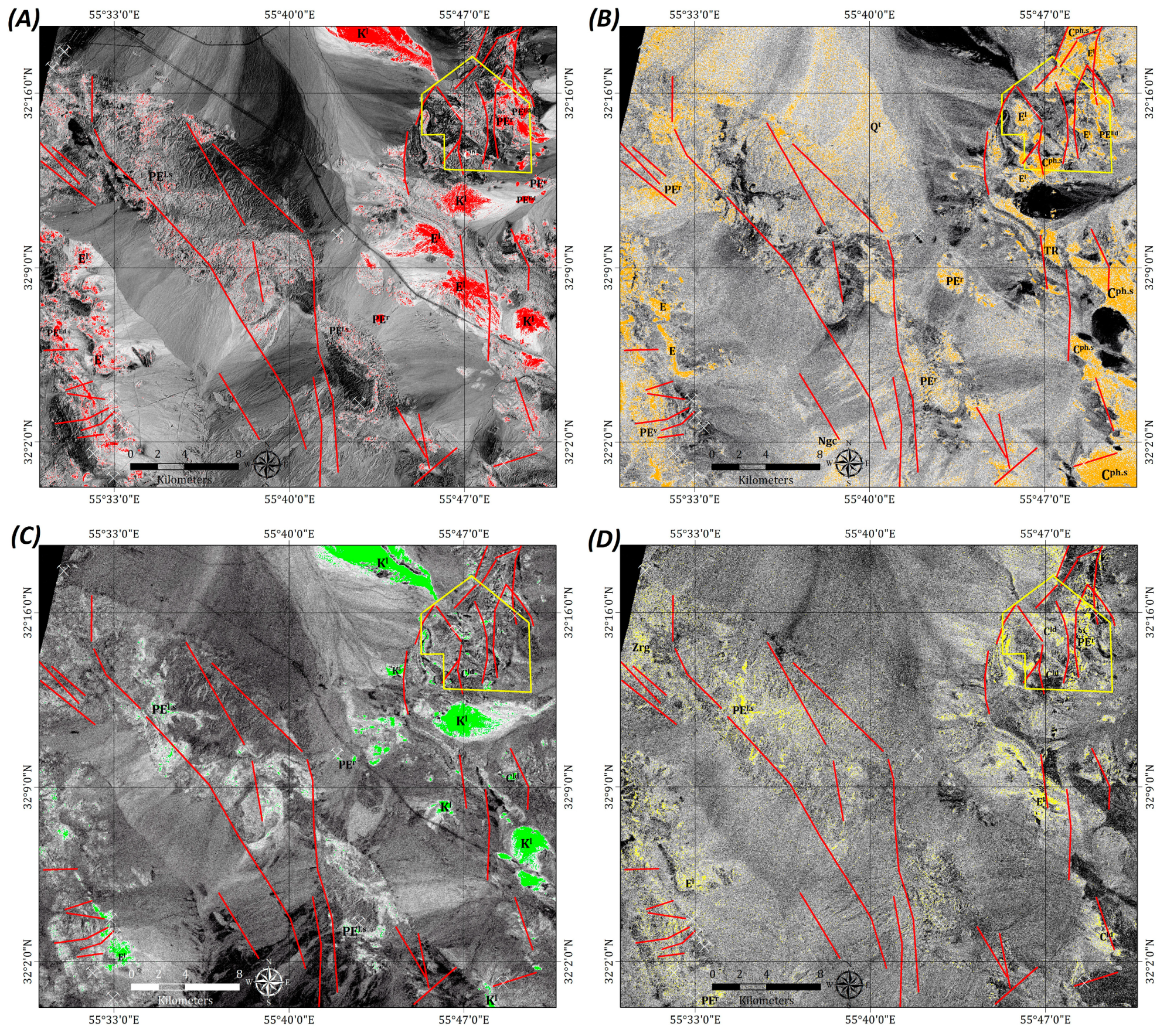
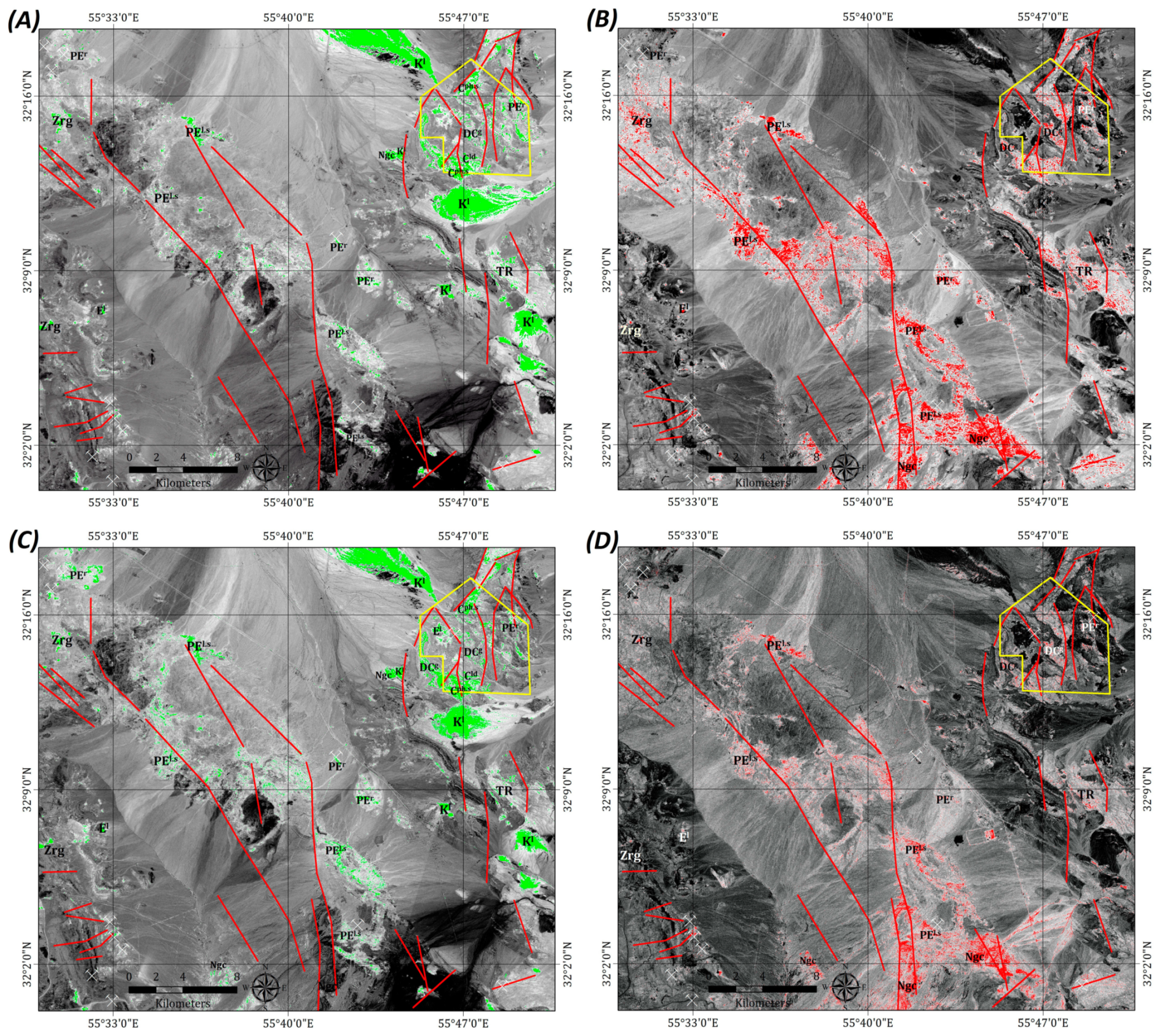


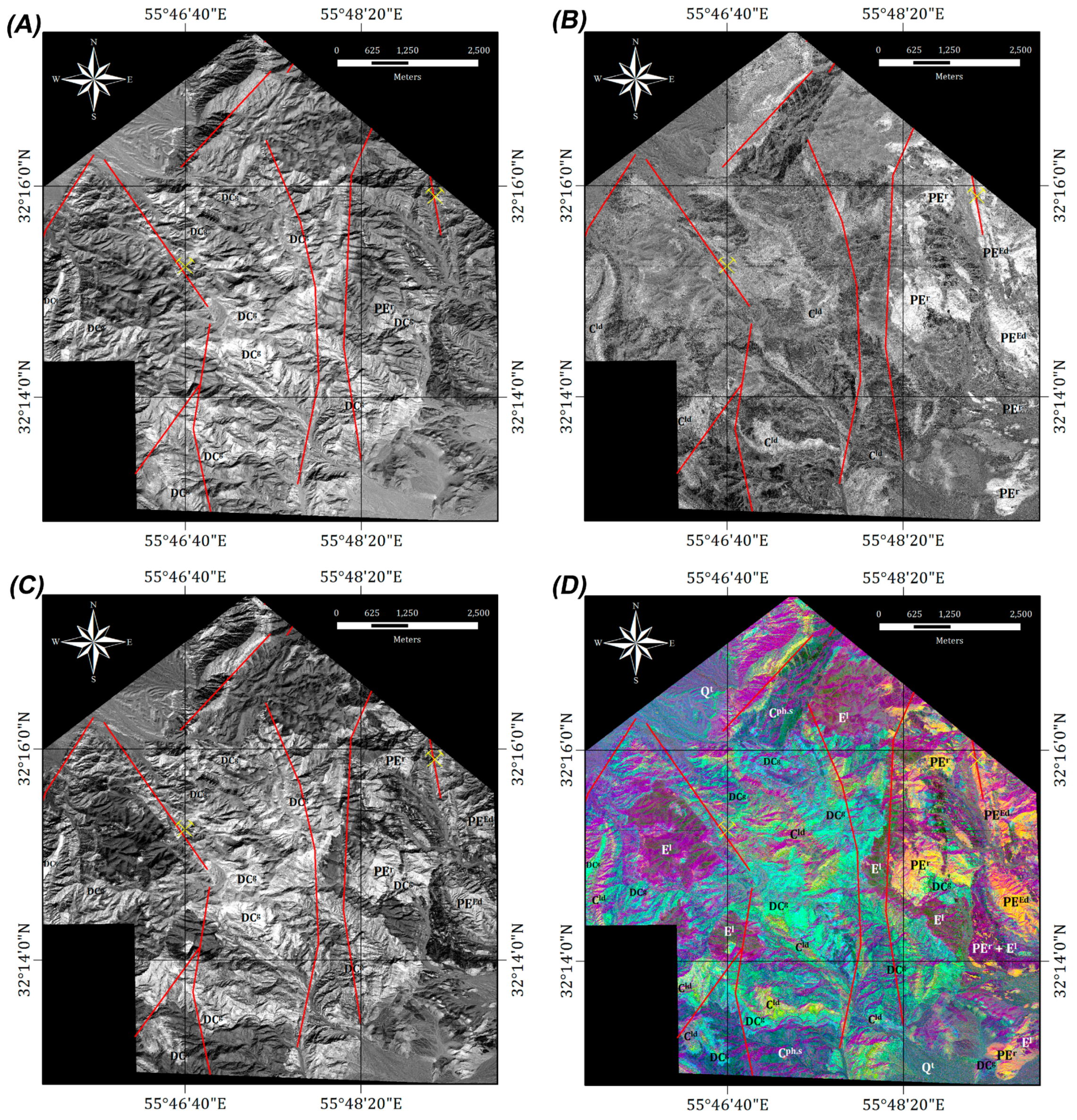
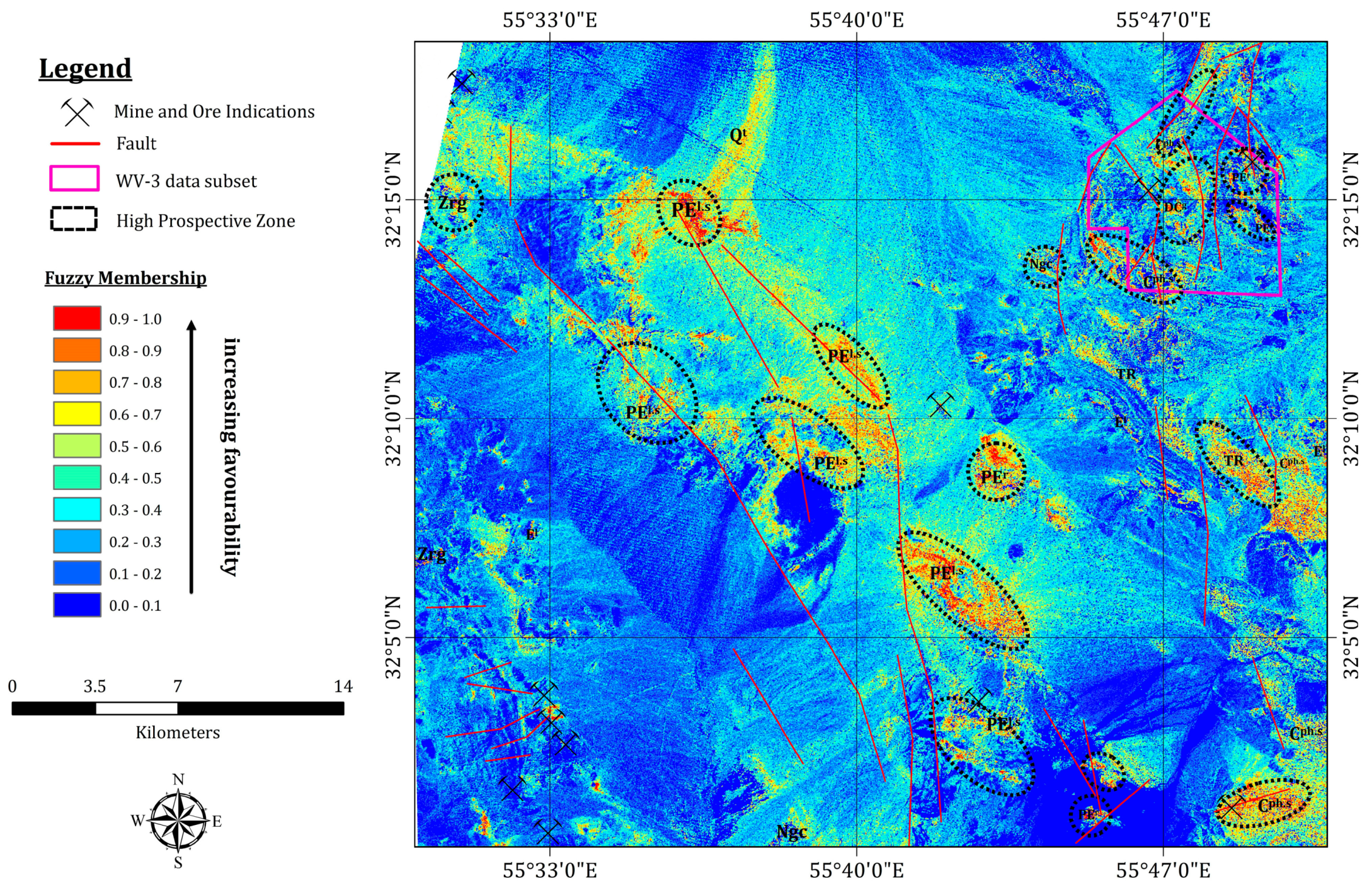
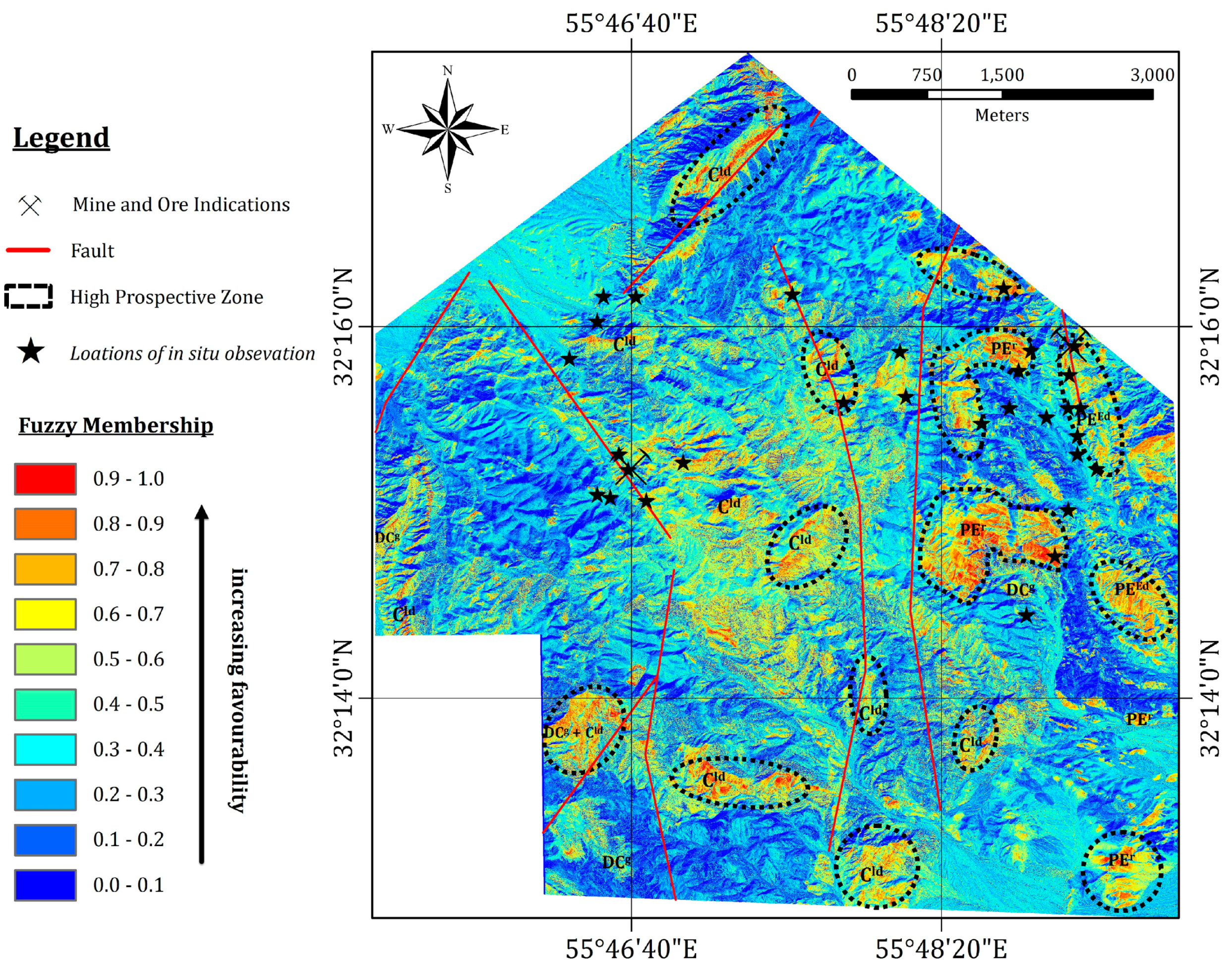
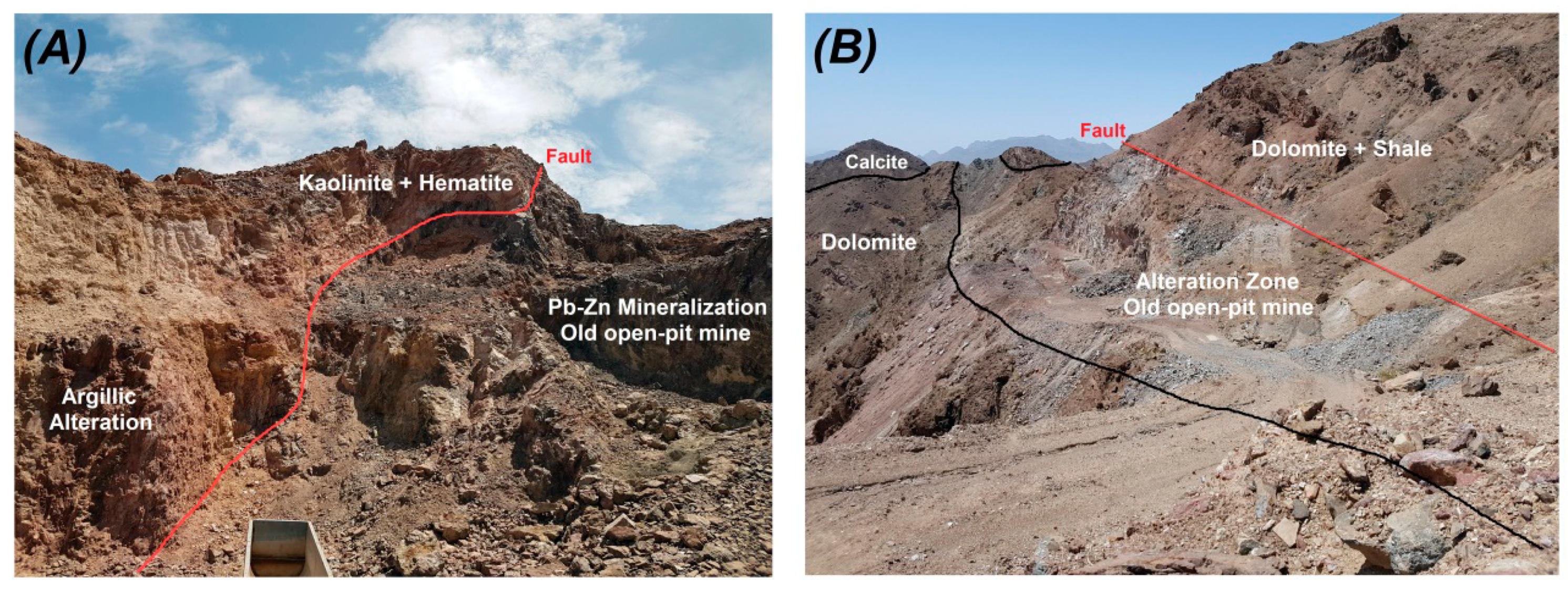

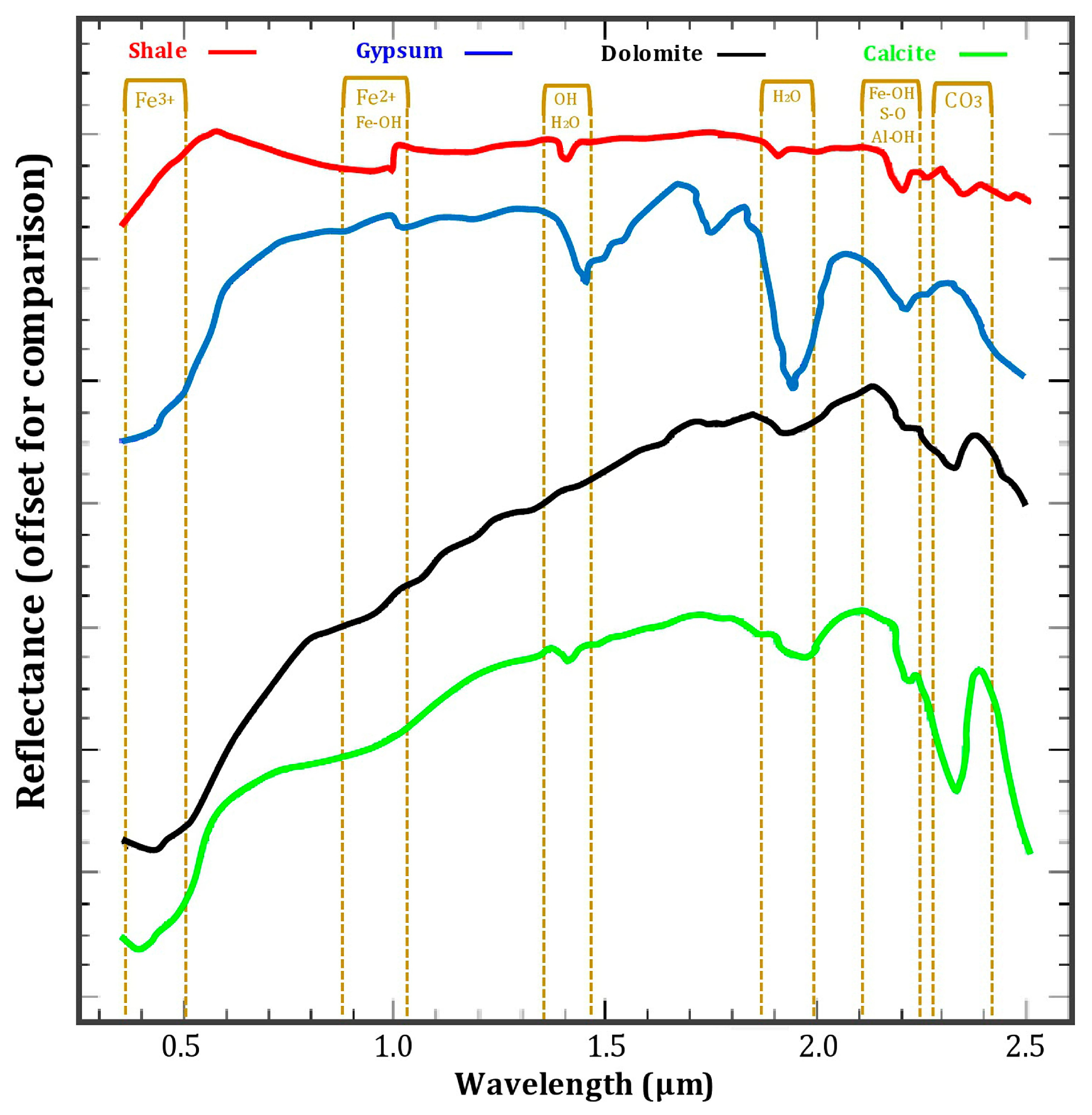
| Sensor | Subsystem | Band Number | Spectral Range (µm) | Ground Resolution (m) | Swath Width (km) | Year of Launch |
|---|---|---|---|---|---|---|
| Landsat-8 | VNIR | PAN (8) | 0.500–0.680 | 15 | 185 | 2013 |
| Coastal aerosol (1) | 0.433–0.453 | 30 | ||||
| Blue (2) | 0.450–0.515 | |||||
| Green (3) | 0.525–0.600 | |||||
| Red (4) | 0.630–0.680 | |||||
| NIR (5) | 0.845–0.885 | |||||
| SWIR | SWIR1 (6) | 1.560–1.660 | ||||
| SWIR2 (7) | 2.100–2.300 | |||||
| Cirrus (9) | 1.360–1.390 | |||||
| TIR | TIRS1 (10) | 10.60–11.19 | 100 | |||
| TIRS2 (11) | 11.50–12.51 | |||||
| Sentinel-2 | VNIR | Coastal aerosol (1) | 0.433–0.453 | 60 | 290 | |
| Blue (2) | 0.458–0.523 | 10 | ||||
| Green (3) | 0.543–0.578 | |||||
| Red (4) | 0.650–0.680 | |||||
| Vegetation Red Edge (5) | 0.698–0.713 | 20 | ||||
| Vegetation Red Edge (6) | 0.733–0.748 | 2015–2017 | ||||
| Vegetation Red Edge (7) | 0.773–0.793 | |||||
| NIR (8) | 0.785–0.900 | 10 | ||||
| Water-vapour (9) | 0.935–0.955 | 60 | ||||
| SWIR | SWIR–Cirrus (10) | 1.360–1.390 | ||||
| SWIR1 (11) | 1.565–1.655 | 20 | ||||
| SWIR2 (12) | 2.100–2.280 | |||||
| ASTER | VNIR | 1 | 0.52–0.60 | 15 | 60 | 1999 |
| 2 | 0.63–0.69 | |||||
| 3N | 0.76–0.86 | |||||
| 3B | 0.76–0.86 | |||||
| SWIR | 4 | 1.600–1.700 | 30 | |||
| 5 | 2.145–2.185 | |||||
| 6 | 2.185–2.225 | |||||
| 7 | 2.235–2.285 | |||||
| 8 | 2.295–2.365 | |||||
| 9 | 2.360–2.430 | |||||
| TIR | 10 | 8.125–8.475 | 90 | |||
| 11 | 8.475–8.825 | |||||
| 12 | 8.925–9.275 | |||||
| 13 | 10.25–10.95 | |||||
| 14 | 10.95–11.65 | |||||
| WV3 | VNIR | Coastal blue (1) | 0.400–0.450 | 1.24 | 13.1 | 2014 |
| Blue (2) | 0.450–0.510 | |||||
| Green (3) | 0.510–0.580 | |||||
| Yellow (4) | 0.585–0.625 | |||||
| Red (5) | 0.630–0.690 | |||||
| Red-edge (6) | 0.705–0.745 | |||||
| NIR1 (7) | 0.770–0.895 | |||||
| NIR2 (8) | 0.860–1.040 | |||||
| SWIR | SWIR-1 (9) | 1.195–1.225 | 3.70 | |||
| SWIR-1 (10) | 1.550–1.590 | |||||
| SWIR-1 (11) | 1.640–1.680 | |||||
| SWIR-1 (12) | 1.710–1.750 | |||||
| SWIR-1 (13) | 2.145–2.185 | |||||
| SWIR-1 (14) | 2.185–2.225 | |||||
| SWIR-1 (15) | 2.235–2.285 | |||||
| SWIR-1 (16) | 2.295–2.365 |
| Eigenvector | Band 1 | Band 2 | Band 3 | Band 4 | Band 5 | Band 6 | Band 7 |
|---|---|---|---|---|---|---|---|
| PC 1 | 0.098888 | 0.127588 | 0.222642 | 0.352134 | 0.470622 | 0.580154 | 0.49225 |
| PC 2 | 0.322223 | 0.372444 | 0.433008 | 0.426627 | 0.230446 | −0.374857 | −0.440827 |
| PC 3 | −0.312408 | −0.354582 | −0.279999 | 0.084637 | 0.59951 | 0.168321 | −0.550787 |
| PC 4 | 0.247724 | 0.269361 | 0.117557 | −0.327086 | −0.247048 | 0.667216 | −0.48894 |
| PC 5 | 0.380773 | 0.318038 | −0.297366 | −0.579504 | 0.516661 | −0.207254 | 0.140427 |
| PC 6 | −0.42878 | −0.07607 | 0.726821 | −0.486822 | 0.193733 | −0.079913 | 0.034331 |
| PC 7 | 0.631338 | −0.734703 | 0.232424 | −0.083794 | 0.022232 | −0.007336 | 0.00581 |
| Eigenvector | Band 2 | Band 3 | Band 4 | Band 8 | Band 11 | Band 12 |
|---|---|---|---|---|---|---|
| PC 1 | −0.15188 | −0.235458 | −0.383398 | −0.466736 | −0.570938 | −0.480298 |
| PC 2 | 0.355822 | 0.405278 | 0.438872 | 0.333419 | −0.451093 | −0.44931 |
| PC 3 | −0.486574 | −0.409713 | 0.064894 | 0.557800 | 0.208124 | −0.486532 |
| PC 4 | −0.310768 | −0.246002 | 0.203541 | 0.259173 | −0.641949 | 0.567634 |
| PC 5 | −0.454829 | 0.100882 | 0.698634 | −0.523627 | 0.113057 | −0.088865 |
| PC 6 | −0.556887 | 0.736037 | −0.355904 | 0.135992 | −0.048461 | 0.024823 |
| Eigenvector | Band 1 | Band 2 | Band 3 | Band 4 | Band 5 | Band 6 | Band 7 | Band 8 | Band 9 |
|---|---|---|---|---|---|---|---|---|---|
| PC 1 | −0.996499 | 0.082351 | −0.008442 | 0.008905 | 0.000780 | 0.005820 | 0.004598 | −0.000774 | −0.000742 |
| PC 2 | 0.075083 | 0.954242 | 0.247544 | −0.134085 | −0.022691 | −0.054521 | −0.030563 | 0.009170 | −0.004727 |
| PC 3 | −0.020004 | −0.185786 | −0.022226 | 0.564435 | −0.157899 | −0.054898 | 0.020914 | −0.896111 | −0.019443 |
| PC 4 | 0.000139 | 0.812776 | 0.124735 | −0.429509 | −0.228138 | −0.025162 | 0.314993 | −0.251698 | −0.002611 |
| PC 5 | −0.021063 | −0.157428 | 0.221774 | −0.668838 | 0.095360 | 0.425904 | −0.014838 | 0.174277 | 0.507113 |
| PC 6 | 0.013032 | 0.083318 | −0.013620 | 0.319148 | 0.388530 | 0.009249 | 0.277101 | −0.329300 | −0.069032 |
| PC 7 | −0.006760 | −0.037927 | −0.034844 | −0.164716 | −0.322506 | −0.352677 | −0.157608 | −0.042499 | 0.084469 |
| PC 8 | −0.016975 | −0.119326 | 0.256410 | 0.404433 | 0.558407 | 0.158777 | −0.623420 | −0.103705 | −0.140444 |
| PC 9 | 0.002032 | 0.009398 | −0.061213 | 0.025598 | −0.153333 | −0.047990 | 0.033235 | −0.028976 | −0.983741 |
| Eigenvector | Band 1 | Band 2 | Band 3 | Band 4 | Band 5 | Band 6 | Band 7 | Band 8 |
|---|---|---|---|---|---|---|---|---|
| PC 1 | −0.314986 | −0.330951 | −0.348156 | −0.359256 | −0.364601 | −0.367182 | −0.369097 | −0.370119 |
| PC 2 | 0.655926 | 0.454510 | 0.183457 | −0.046042 | −0.154854 | −0.251952 | −0.320189 | −0.370709 |
| PC 3 | −0.331273 | −0.598506 | 0.354295 | −0.129646 | 0.661001 | −0.220796 | 0.341420 | 0.108973 |
| PC 4 | −0.244961 | 0.345377 | 0.145561 | 0.631659 | 0.012267 | 0.368220 | −0.509311 | −0.142316 |
| PC 5 | −0.384633 | 0.279151 | 0.433976 | −0.092808 | 0.081588 | −0.370014 | −0.142544 | 0.187618 |
| PC 6 | 0.236442 | −0.427799 | −0.515988 | −0.065670 | 0.646312 | 0.248715 | 0.043257 | 0.095274 |
| PC 7 | 0.257771 | −0.301701 | −0.070317 | −0.389055 | 0.471694 | 0.225588 | −0.427691 | 0.035215 |
| PC 8 | 0.174655 | −0.560947 | 0.307690 | −0.163685 | −0.332755 | 0.108819 | 0.068151 | −0.001993 |
| Data Origin | Input Layer | Detection | Membership Type | Fuzzy Operator |
|---|---|---|---|---|
| Landsat-8 Dataset | PC4 | OH-minerals and Carbonates | Linear | Gamma (γ = 0.7) |
| PC5 | Iron Oxide | |||
| Sentinel-2 Dataset | PC4 | OH-minerals and Carbonates | ||
| PC5 | Iron Oxide | |||
| ASTER Dataset | PC4 | Iron oxide/hydroxides minerals | Linear | Gamma (γ = 0.7) |
| PC5 | OH/S-O/CO3-bearing minerals | |||
| PC8 | Dolomite | |||
| WV-3 Dataset | PC3 | Iron-stained alteration | Linear | Gamma (γ = 0.7) |
| PC4 | Dolomite/Fe2+ oxides | |||
| PC6 | Fe3+ oxides |
| (A) Alteration Map Landsat-8 | GPS Survey | ||||||
| Iron Oxide/Hydroxides | OH-Bearing and Carbonate Minerals | Totals | User’s Accuracy | ||||
| Iron oxide/hydroxides | 4 | 2 | 6 | 67% | |||
| OH-bearing and carbonate minerals | 2 | 22 | 24 | 91% | |||
| Totals | 6 | 24 | 30 | ||||
| Producer’s accuracy | 67% | 91% | |||||
| Overall accuracy = 86.66% | Kappa Coefficient = 0.83 | ||||||
| (B) Alteration Map Sentinel-2 | GPS Survey | ||||||
| Iron Oxide/Hydroxides | OH-Bearing Minerals | Totals | User’s Accuracy | ||||
| Iron oxide/hydroxides | 5 | 2 | 7 | 71% | |||
| OH-bearing minerals | 1 | 10 | 11 | 90% | |||
| Totals | 6 | 12 | 18 | ||||
| Producer’s accuracy | 83% | 83% | |||||
| Overall accuracy = 83.33% | Kappa Coefficient = 0.81 | ||||||
| (C) Alteration Map ASTER | GPS Survey | ||||||
| Iron Oxide/ Hydroxides | Argillic Alteration+ Shale | Gypsum | Calcite | Dolomite | Totals | User’s Accuracy | |
| Iron oxide/hydroxides | 4 | 0 | 0 | 0 | 1 | 5 | 80% |
| Argillic alteration + Shale | 0 | 4 | 2 | 1 | 0 | 7 | 57% |
| Gypsum | 0 | 2 | 4 | 0 | 0 | 6 | 67% |
| Calcite | 0 | 0 | 0 | 5 | 1 | 6 | 83% |
| Dolomite | 2 | 0 | 0 | 0 | 4 | 6 | 67% |
| Totals | 6 | 6 | 6 | 6 | 6 | 30 | |
| Producer’s accuracy | 67% | 67% | 67% | 83% | 67% | ||
| Overall accuracy = 70% | Kappa Coefficient = 0.68 | ||||||
| (D) Alteration Map WV-3 | GPS Survey | ||||||
| Iron Oxide/Hydroxides | Dolomite | Totals | User’s Accuracy | ||||
| Iron oxide/hydroxides | 5 | 1 | 6 | 83% | |||
| Dolomite | 1 | 5 | 6 | 83% | |||
| Totals | 6 | 6 | 12 | ||||
| Producer’s accuracy | 83% | 83% | |||||
| Overall accuracy = 83.33% | Kappa Coefficient = 0.82 | ||||||
© 2020 by the authors. Licensee MDPI, Basel, Switzerland. This article is an open access article distributed under the terms and conditions of the Creative Commons Attribution (CC BY) license (http://creativecommons.org/licenses/by/4.0/).
Share and Cite
Sekandari, M.; Masoumi, I.; Beiranvand Pour, A.; M Muslim, A.; Rahmani, O.; Hashim, M.; Zoheir, B.; Pradhan, B.; Misra, A.; Aminpour, S.M. Application of Landsat-8, Sentinel-2, ASTER and WorldView-3 Spectral Imagery for Exploration of Carbonate-Hosted Pb-Zn Deposits in the Central Iranian Terrane (CIT). Remote Sens. 2020, 12, 1239. https://doi.org/10.3390/rs12081239
Sekandari M, Masoumi I, Beiranvand Pour A, M Muslim A, Rahmani O, Hashim M, Zoheir B, Pradhan B, Misra A, Aminpour SM. Application of Landsat-8, Sentinel-2, ASTER and WorldView-3 Spectral Imagery for Exploration of Carbonate-Hosted Pb-Zn Deposits in the Central Iranian Terrane (CIT). Remote Sensing. 2020; 12(8):1239. https://doi.org/10.3390/rs12081239
Chicago/Turabian StyleSekandari, Milad, Iman Masoumi, Amin Beiranvand Pour, Aidy M Muslim, Omeid Rahmani, Mazlan Hashim, Basem Zoheir, Biswajeet Pradhan, Ankita Misra, and Shahram M. Aminpour. 2020. "Application of Landsat-8, Sentinel-2, ASTER and WorldView-3 Spectral Imagery for Exploration of Carbonate-Hosted Pb-Zn Deposits in the Central Iranian Terrane (CIT)" Remote Sensing 12, no. 8: 1239. https://doi.org/10.3390/rs12081239
APA StyleSekandari, M., Masoumi, I., Beiranvand Pour, A., M Muslim, A., Rahmani, O., Hashim, M., Zoheir, B., Pradhan, B., Misra, A., & Aminpour, S. M. (2020). Application of Landsat-8, Sentinel-2, ASTER and WorldView-3 Spectral Imagery for Exploration of Carbonate-Hosted Pb-Zn Deposits in the Central Iranian Terrane (CIT). Remote Sensing, 12(8), 1239. https://doi.org/10.3390/rs12081239









